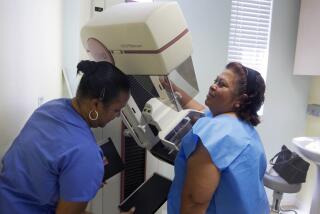A change in routine for Pap testing
- Share via
For years, women have known that beginning at age 18 -- and every year for the rest of their lives -- they were supposed to get a Pap smear. In many cases, that test was the only reason they visited a doctor.
The annual ritual was effective, making the Pap smear one of the great cancer-fighting successes. Because the test catches cell changes before they become deadly, it has cut cervical cancer deaths by more than 70% in the last 50 years.
About 13,000 women are diagnosed each year in the United States and 4,100 die -- often because they weren’t screened and their cancer was advanced by the time it was discovered.
But the routine soon may change for some women. Based on evidence that slow-growing cervical cancers are infrequent in the very young and the very old, new guidelines from the American Cancer Society recommend that women start getting the annual tests at age 21 or three years after they’ve become sexually active. They may choose to stop having Pap smears at age 70 as long as they’ve been screened regularly up until that age. And, the guidelines say, women who have undergone hysterectomies that included removal of the cervix don’t need the tests.
Although women should continue undergoing annual Pap screenings throughout their 20s (or new liquid-based Pap tests every two years), the guidelines say, a woman older than 30 who has had three normal tests in a row should then be screened every two or three years.
“What’s driving this is that overscreening is actually doing harm to people,” said Debbie Saslow, director of breast and gynecological cancer for the American Cancer Society. Some mildly abnormal results or false positives often lead to expensive, invasive follow-ups, she said.
The new guidelines, published in the November-December journal CA: A Cancer Journal for Clinicians, say some women may need more frequent screenings, including those with HIV, those whose mothers took the drug diethylstilbestrol, or DES, in pregnancy, those with cervical cancer history, and sexually abused teens.
The first revision in the guidelines since 1987 represents a consensus by a panel of specialists in obstetrics-gynecology, gynecological cancers, adolescent medicine and the human papilloma virus, or HPV. Infection with the virus is the top cause of cervical cancer.
Saslow said that although 70% of college-age women are infected with the human papilloma virus, it generally creates only minor abnormalities on Pap smears that often go away by themselves in young women. It takes three to five years for any pre-cancerous cervical cells to become cancerous, so waiting until age 21 or three years after young women begin having sex leaves time to catch any problems without overtreating the patient, she said.
Aware that Pap smears are often the sole reason women visit doctors, Saslow said that easing Pap smear requirements shouldn’t mean letting up on ob-gyn care. “We need to get rid of this fallacy that the only reason you go to the ob-gyn is to get a Pap smear,” Saslow said. Sexually active women still need to discuss birth control and be screened for sexually transmitted diseases.
Dr. Eric Book, chief medical officer for Blue Shield of California, which insures about 1 million women, said the recommendations for less screening won’t change coverage for Blue Shield subscribers. The health plan follows guidelines from the U.S. Preventive Services Task Force, which recommends annual screenings beginning at age 18 or earlier if a young woman is sexually active; and at least every three years once she has two consecutive normal tests.






